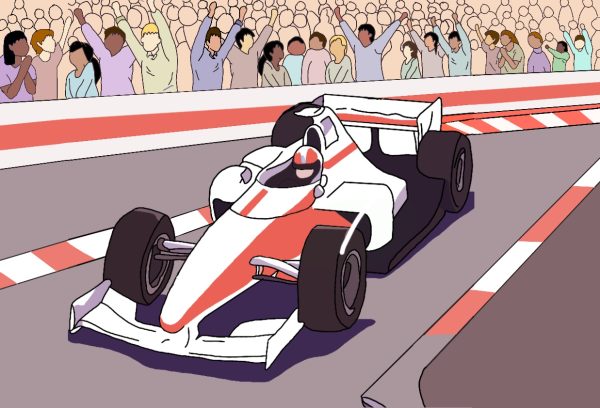
It’s the inaugural Formula One Grand Prix in Las Vegas. The stands buzz with excitement, hosting fans ranging from Harker students to celebrities like Rihanna and Justin Bieber. Together, they witness the clash of the world’s twenty highest-ranked racecar drivers in a fusion of adrenaline and speed.
F1 features 10 teams, each with two drivers to promote teamwork among the race engineers and strategic managers to earn points for their two drivers. This system helps maintain a balance between the funding required and the competitive abilities of each team. Although two drivers are on the same team, they still compete as individual drivers throughout the season. In each race, only the top 10 drivers earn points, with the winner receiving 25 points, and points are totaled at the season’s end to determine the championship winner.
The 2023 F1 season comprised of 23 races and concluded on Nov. 26 in Abu Dhabi. Red Bull Racing driver Max Verstappen secured the championship, with his teammate Sergio Perez finishing in second place.
Although F1 can present challenges for individual participation due to its expenses and time commitment, it remains an entertaining sport for spectators. With only space for 20 primary drivers and 10 teams each season, securing an opportunity to race demands skill and diligence.
The sport’s competitiveness, with its intense battles and dramatic overtakes, is a significant draw for fans. A notable instance occurred in the Las Vegas GP, when Ferrari driver Charles Leclerc overtook Perez in the last lap, securing a second-place finish and the fan-voted Driver of the Day award. For many F1 fans like Shivraj Panja (11), it’s these exhilarating battles that consistently captivate them.
“My favorite part about F1 is the high-speed cars and the competitiveness of the sport,” Shivraj said. “I watch most parts of the races, and I like the overtakes the best. They make it more popular, so more people are talking about it this year.”
After the United States struggled to break into the F1 market for many years due to limited exposure, the very first Las Vegas GP this year brought more attention to F1 in the US. In 2022, ESPN’s channel averaged 1.21 million viewers during F1 races, double the number of viewers they achieved in 2020.
“Drive to Survive,” a Netflix documentary series, served as a catalyst of viewership. The show displays both the fierce competitiveness of the sport and the intimate emotions of the people involved in F1 encompassing drivers, race engineers and fans alike. Sophomore Judi Abdelrazik, who attended the Las Vegas Grand Prix, watched her first GP after “Drive to Survive” introduced her to the sport.
“The Netflix series does a lot for the sport to show the emotions in the race,” Judi said. “During the race, you don’t really see the drivers crying or smiling, but the show creates a connection between the fans and them. It definitely helps you understand what things are happening behind the scenes.”

Even in the competitive realm of F1, where disputes between drivers and teams often arise, the drivers come together off the track. On social media, the drivers collaborate on content like Secret Santas and “Grill the Grid.” These recorded interactions show the tightly-knit nature of the F1 community, providing a genuine and uplifting message for fans about the sport’s supportive nature.
Many viewers enjoy the sport for more than just the races themselves, and numerous social media fan pages like @shreyaf1 on TikTok delve into various aspects of the sport. Senior F1 fan Rhiannon Sikand observes the impacts of external influences on F1’s popularity.
“I’ve seen on social media that a lot of people are making videos about the drivers,” Rhiannon said. “Part of that’s probably because it was a good season, and it was in the news. But people also started noticing that they liked the drivers and interactions, and there was a new market for the audience.”
Women also constitute a large and growing demographic of its viewers, accounting for 65% of new F1 fans. The increase in female engagement has not only opened up opportunities for F1 to challenge gender stereotypes and reshape the fandom but also aligned with F1 Academy, the championship dedicated to female drivers, which had its inaugural season this year.
In October, F1 Academy driver Bianca Bustamante also became the first female driver to enroll in the McLaren Driver Development program, where current F1 drivers like Oscar Piastri and Lewis Hamilton trained. Her presence in the program fosters hope among young women in the F1 community, whether they are aspiring drivers or racecar enthusiasts.
“A lot of the new people who are watching it are young women,” Rhiannon said. “It’s because they’re realizing that they can still find enjoyment in this field that was once not targeted towards women. That’s a testament to how markets are changing not only in the age of social media, but also as women start to explore new industries, like Formula One.”
As F1 continues to grow its fanbase, its aim to promote collaboration and embrace diversity transforms the world of high-speed racing into a global community, where fans of different backgrounds bond through their shared passion for this uniting sport.


















![“[Building nerf blasters] became this outlet of creativity for me that hasn't been matched by anything else. The process [of] making a build complete to your desire is such a painstakingly difficult process, but I've had to learn from [the skills needed from] soldering to proper painting. There's so many different options for everything, if you think about it, it exists. The best part is [that] if it doesn't exist, you can build it yourself," Ishaan Parate said.](https://harkeraquila.com/wp-content/uploads/2022/08/DSC_8149-900x604.jpg)




![“When I came into high school, I was ready to be a follower. But DECA was a game changer for me. It helped me overcome my fear of public speaking, and it's played such a major role in who I've become today. To be able to successfully lead a chapter of 150 students, an officer team and be one of the upperclassmen I once really admired is something I'm [really] proud of,” Anvitha Tummala ('21) said.](https://harkeraquila.com/wp-content/uploads/2021/07/Screen-Shot-2021-07-25-at-9.50.05-AM-900x594.png)







![“I think getting up in the morning and having a sense of purpose [is exciting]. I think without a certain amount of drive, life is kind of obsolete and mundane, and I think having that every single day is what makes each day unique and kind of makes life exciting,” Neymika Jain (12) said.](https://harkeraquila.com/wp-content/uploads/2017/06/Screen-Shot-2017-06-03-at-4.54.16-PM.png)








![“My slogan is ‘slow feet, don’t eat, and I’m hungry.’ You need to run fast to get where you are–you aren't going to get those championships if you aren't fast,” Angel Cervantes (12) said. “I want to do well in school on my tests and in track and win championships for my team. I live by that, [and] I can do that anywhere: in the classroom or on the field.”](https://harkeraquila.com/wp-content/uploads/2018/06/DSC5146-900x601.jpg)
![“[Volleyball has] taught me how to fall correctly, and another thing it taught is that you don’t have to be the best at something to be good at it. If you just hit the ball in a smart way, then it still scores points and you’re good at it. You could be a background player and still make a much bigger impact on the team than you would think,” Anya Gert (’20) said.](https://harkeraquila.com/wp-content/uploads/2020/06/AnnaGert_JinTuan_HoHPhotoEdited-600x900.jpeg)

![“I'm not nearly there yet, but [my confidence has] definitely been getting better since I was pretty shy and timid coming into Harker my freshman year. I know that there's a lot of people that are really confident in what they do, and I really admire them. Everyone's so driven and that has really pushed me to kind of try to find my own place in high school and be more confident,” Alyssa Huang (’20) said.](https://harkeraquila.com/wp-content/uploads/2020/06/AlyssaHuang_EmilyChen_HoHPhoto-900x749.jpeg)



